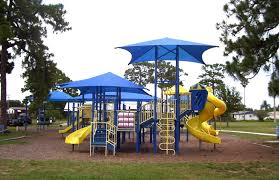Key Factors: Shade Sail Installation
Are you considering a shade sail? Here are a few key factors to consider before installing your new shade!
Sun Position
As you know, the sun moves from East to West during the day. That means that the size and location that a shade sail will provide will shift throughout the day AND year. Depending on where you the sun will be directly overhead at different times of the day. So, depending on what your goal is for your shade sail, you may place it a little differently. For example, a school may choose to place a shade so that at lunchtime, the picnic tables are shaded. That same shade sail may provide ample shade for the playground that is used at 3pm. However, at 3pm, the same picnic tables may be completely unshaded!
Wind Condition, Direction and Strength
Some locations have pretty consistent prevailing winds and it is possible to predict the main direction and strength of the wind from day-to-day, season-to-season. However, these same locations may have strong gusts during a storm. Particularly windy areas do better with a set of smaller shades, although this can bring up the cost to have multiple posts and multiple shades. So, knowing where the wind comes from and then if the area is prone to significant storms will help determine best shades and installation, (and if the shades are designed to come down when bad weather is expected).
Strength of Existing Mounting Points
Once you have decided where your shade needs to be to get the shade you require, you then need to look for suitable mounting points. These can be to an existing structure or to installed steel posts. The posts require digging and setting in concrete, but are very strong. There are some installations that can be done with one or more points to an existing structure, however careful consideration must be made. Often a client will point to a tree or the side of a home as a potential mounting point, however, these provide their own challenges and may not be strong enough depending on sail size and weather conditions in the area.
Changes in Height
Flat or horizontal shade installation may seem to make sense – and provide the most shade, however, they can cause issues with pooling water and leaves that collect. That can in turn cause staining or tears or stretching, mold and algae. We recommended your shade sails are installed at an angle to avoid these issues and let the rain and debris fall right off. This will improve the life of the sail.
Shape
Shade sails generally are not perfectly square or perfectly triangular. The dimensions you are given are for the length between the corners of the shade but the shade itself does not follow these straight lines. The inward curve of the shade is called the ‘hollow’ and it helps distribute the tension evenly and stops the middle from sagging and the shade from flapping and wrinkling.
If you would like more information on Shade Sail Installation, contact us today!

